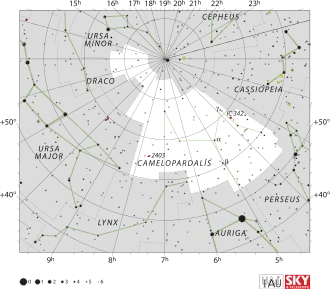BE Camelopardalis
BE Camelopardalis (kurz BE Cam) ist ein dem bloßen Auge als lichtschwach erscheinender veränderlicher Stern im nördlichen, zirkumpolaren Sternbild Giraffe (lateinisch Camelopardalis). Seine mittlere scheinbare Helligkeit beträgt 4,39m. Nach im Dezember 2020 veröffentlichten Auswertungen der Messergebnisse der Raumsonde Gaia ist der Stern etwa 980 Lichtjahre von der Erde entfernt.[1]
| Stern BE Camelopardalis | |||||||||||||
|---|---|---|---|---|---|---|---|---|---|---|---|---|---|
 | |||||||||||||
| AladinLite | |||||||||||||
| Beobachtungsdaten Äquinoktium: J2000.0, Epoche: J2000.0 | |||||||||||||
| Sternbild | Giraffe | ||||||||||||
| Rektaszension | 03h 49m 31,28s [1] | ||||||||||||
| Deklination | +65° 31′ 33,5″ [1] | ||||||||||||
| Helligkeiten | |||||||||||||
| Scheinbare Helligkeit | 4.35–4.48 mag [2] | ||||||||||||
| Spektrum und Indices | |||||||||||||
| Veränderlicher Sterntyp | Lc [2] | ||||||||||||
| B−V-Farbindex | +1,88 [3] | ||||||||||||
| U−B-Farbindex | −2,13 [3] | ||||||||||||
| R−I-Index | +1,42 [3] | ||||||||||||
| Spektralklasse | M2 II [4] | ||||||||||||
| Astrometrie | |||||||||||||
| Radialgeschwindigkeit | (−1.70 ± 1.47) km/s [5] | ||||||||||||
| Parallaxe | (3.3288 ± 0.1847) mas [1] | ||||||||||||
| Entfernung | (980 ± 50) Lj (300 ± 16) pc [1] | ||||||||||||
| Visuelle Absolute Helligkeit Mvis | −3,0 mag [Anm 1] | ||||||||||||
| Eigenbewegung [1] | |||||||||||||
| Rek.-Anteil: | (+0.319 ± 0.075) mas/a | ||||||||||||
| Dekl.-Anteil: | (−15.593 ± 0.135) mas/a | ||||||||||||
| Physikalische Eigenschaften | |||||||||||||
| Masse | 2.93 M☉ [6] | ||||||||||||
| Radius | 176 R☉ [7] | ||||||||||||
| Effektive Temperatur | (3615 ± 170) K [7] | ||||||||||||
| Andere Bezeichnungen und Katalogeinträge | |||||||||||||
| |||||||||||||
| Anmerkung | |||||||||||||
| |||||||||||||
Wahrscheinlich ist BE Camelopardalis ein Einzelstern.[8] Er ist ein rot leuchtender, heller Riese der Spektralklasse M2 II,[4] der bereits seinen im Sterninneren vorhandenen Wasserstoff-Vorrat durch Kernfusion verbraucht und damit ein spätes Entwicklungsstadium erreicht hat. Derzeit befindet er sich im Hertzsprung-Russell-Diagramm auf dem asymptotischen Riesenast und ist auf einen Durchmesser von etwa 176 Sonnendurchmesser expandiert.[7] Er gehört zu den langsam unregelmäßig veränderlichen Sternen; seine scheinbare Helligkeit schwankt geringfügig von 4,35m bis 4,48m.[2] Seine effektive Temperatur ist deutlich geringer als jene der Sonne; sie beträgt etwa 3600 Kelvin.[7]
Weblinks
Anmerkungen
- Gaia early data release 3 (Gaia EDR3) für BE Cam, Dezember 2020
- BE Cam, in The International Variable Star Index.
- J. R. Ducati: VizieR Online Data Catalog: Catalogue of Stellar Photometry in Johnson's 11-color system. In: CDS/ADC Collection of Electronic Catalogues. 2237, 2002. bibcode:2002yCat.2237....0D. (Datensatz auf VizieR)
- Philip C. Keenan, Raymond C. McNeil: The Perkins Catalog of Revised MK Types for the Cooler Stars. In: Astrophysical Journal Supplement. 71, 1989, S. 245–266. bibcode:1989ApJS...71..245K. doi:10.1086/191373. (Datensatz auf VizieR)
- E. Anderson, Ch. Francis: XHIP: An extended hipparcos compilation. In: Astronomy Letters. 38, Nr. 5, 2012, S. 331–346. arxiv:1108.4971. bibcode:2012AstL...38..331A. doi:10.1134/S1063773712050015. (Datensatz auf VizieR)
- M. M. Hohle, R. Neuhäuser, B. F. Schutz: Masses and luminosities of O- and B-type stars and red supergiants. In: Astronomische Nachrichten. 331, Nr. 4, 2010, S. 349. arxiv:1003.2335. bibcode:2010AN....331..349H. doi:10.1002/asna.200911355. (Datensatz auf VizieR)
- M. Messineo, A. G. A. Brown: A Catalog of Known Galactic K-M Stars of Class I Candidate Red Supergiants in Gaia DR2. In: The Astronomical Journal. 158, Nr. 1, 2019, S. 20. arxiv:1905.03744. bibcode:2019AJ....158...20M. doi:10.3847/1538-3881/ab1cbd. (Datensatz auf VizieR)
- P. P. Eggleton, A. A. Tokovinin: A catalogue of multiplicity among bright stellar systems. In: Monthly Notices of the Royal Astronomical Society. 389, Nr. 2, September 2008, S. 869–879. arxiv:0806.2878. bibcode:2008MNRAS.389..869E. doi:10.1111/j.1365-2966.2008.13596.x.